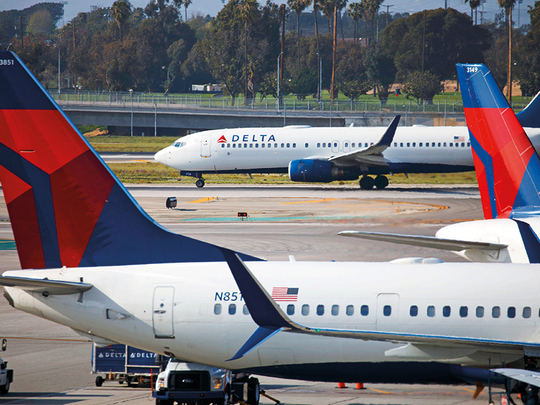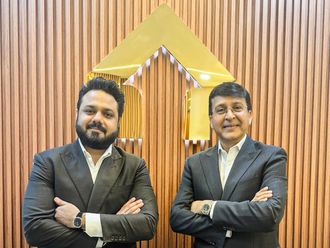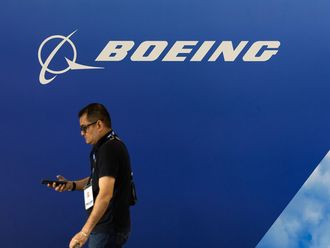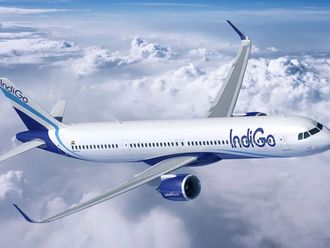
For travellers intrepid enough to share an aircraft with a group of strangers in the grip of an epidemic, now is a great time for bargains.
Americans can get return flights from New York to Miami right now for around $51 (Dh187). In China, premium budget carrier Juneyao Airlines Co is offering one-way tickets for the three-and-a-half hour journey from Shanghai to Chengdu for just 90 yuan ($13) plus taxes.
Seats on aeroplanes are a commodity just as much as barrels of oil or bushels of wheat. When demand plummets, as it’s doing at the moment, the ideal situation is to cut supply as well — but it’s harder for an airline to cancel flights and consolidate passengers than it is for a miner to slow down its excavators. So often the most viable way to clear the market is drastic price cuts.
A way to profit
Look at airlines’ cost structures, however, and it becomes apparent that such bargain-basement prices aren’t just an act of desperation. Indeed, they can even enhance profitability.
Consider the bargain a colleague scored recently. On a flight from Bali back to his home in Singapore next week, he’ll be paying precisely zero dollars for his ticket on Singapore Airlines Ltd.’ s flagship full-service carrier. Of course, that’s impossibly low, and he was only able to get it once he’d promised to spend S$326 ($235) on the outbound leg — so in truth, he’s paying S$163 each way.
Bundling a crazy-cheap ticket with a standard-price one is a common way of keeping the perceived price of a “normal” fare high while discouraging passengers from shopping around.
Surfeit of fixed costs
Margins are the real explanation here. Once an airline has decided to operate a flight, almost all its costs are fixed. Minimum maintenance spending and staffing levels are more or less set by regulation, so won’t much vary according to how many people are on board.
Even fuel, one of the biggest expenses for carriers, isn’t really affected by your decision to add yourself to the payload: Passengers and cargo make up only about 20-30 per cent of the weight of a plane at take-off, so the increment associated with Dan and his luggage is probably not much more than S$5.
The only other place a full-service airline is spending extra money by taking on an additional passenger is in the $10 or less it spends on each meal. Budget carriers, which get passengers to pay for food and drink — and typically make better margins on these ancillaries than on their core aviation businesses — don’t even have that to worry about.
Everything else is a plus
Those extraordinarily high fixed costs mean that once an airline has booked enough seats to break even on the flight as a whole, tickets it sells at any price above the marginal cost of fuel and food should enhance profitability. Almost the only thing putting a floor under fares at that point is the desire to “anchor” their perceived value at a higher level, lest passengers come to expect nickel-and-dime pricing as the normal situation.
A rough model of Daniel’s flight shows how this works. The journey covers 1,668 kilometres and the Boeing Co. 787-10 he’ll be taking has 301 economy seats and 36 in business class. Relatively new, fuel-efficient 787s will likely have cheaper costs than the average in Singapore Airlines’ fleet, but let’s assume they’re in line with the average last fiscal year of 8.3 Singapore cents per seat, per kilometre flown.
On that basis, the whole flight costs about S$46,656 to operate.
Then assume each economy ticket is sold for the S$163 he’s paying and every business class ticket for the S$658 currently quoted on Singapore Airlines’ booking site.
It all adds up
Suddenly that bargain-basement flight is looking quite lucrative: Even if just 80 per cent of tickets are sold in each class, the operating profit should be S$11,545, a 20 per cent margin. Split the economy cabin into enough different fare buckets, and it’s even possible to sell tickets at Juneyao-style prices and end up with better profits than if you left them empty, give or take the cost of an in-flight meal.
That doesn’t quite account for everything. Finance costs have to be paid, and you want to be making outsize margins on many of your flights to make up for the fact that other ones will barely break even.
Ideally, there might even be some cash left over for dividends, too — but this is aviation, so who are we kidding?
Somehow, airlines have managed to spin a viable business out of minuscule margins spread across millions of individual tickets, but it’s never been easy, especially when pandemics are stalking the earth.
Even in the good times, carriers make about as much profit on a typical fare as you’ll pay for that slightly stale sandwich from the trolley. Next time you’re tempted to rage against profiteering airlines, spare a thought for the poor shareholders.








